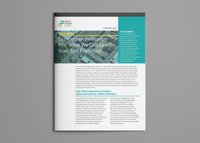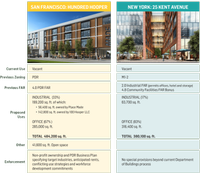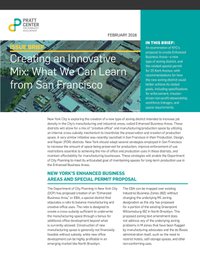This issue brief examines New York City’s proposal to create Enhanced Business Areas—a new type of mixed use commercial-industrial zoning district—and its application at the block-through development at 25 Kent Avenue in Williamsburg, Brooklyn. The project developers were awarded a special permit to build additional office space in exchange for the provision of light industrial uses. The larger rezoning plan for the neighborhood that would have facilitated similar office developments in the neighborhood was scrapped by the City Planning commission.
Drawing on best practices from San Francisco, the brief offers recommendations for how the new zoning district could better achieve its stated goals, including specific recommendations for enforcement of uses, mission driven non-profit stewardship, workforce linkages, and space requirements.

Cities around the United States are exploring new strategies to nurture “Innovation Districts” intended to be a mix of production and office uses to stimulate the creation of new products, businesses and jobs. New York City has proposed Enhanced Business Areas zoning, its version of a new type of mixed use district that would leverage higher rent “creative-office” uses as an internal cross-subsidy mechanism to incentivize the preservation and creation of production space.
This brief contrasts the New York approach, illustrated by the mapping at 25 Kent in Greenpoint, Brooklyn, with a similar initiative in San Francisco, illustrated by Hundred Hooper in their Dogpatch District. The success of the San Francisco project is be a guidepost to explore NYC’s effort to plan hybrid commercial and light manufacturing uses within one development scheme, which would help preserve and stimulate manufacturing activities that are so rich in employment opportunity and mobility for New Yorkers.

Findings
New York City’s model as illustrated by the recently proposed Enhanced Business Area does not go far enough in holding the development accountable to the original intended uses and we recommend greater fidelity to the model piloted by San Francisco.
Recommendations
There are two major differences between the New York City and San Francisco models - the amount of space dedicated for production and the conveyance of a portion of the production space to a non-profit to facilitate enforcement of use restrictions and advance public policy objectives, including hiring local residents. The report recommends:
- Increase the amount of space dedicated for production in Enhanced Business Areas.
- Require that any production space created through a special permit be owned and/or operated by a nonprofit organization.
- Better integrate planning, economic development and workforce development initiatives beginning with requiring the developer to provide a plan for attracting and support industrial businesses.
- Include a “look-back” provision to ensure that the creation of new production space does not create an incentive to displace existing manufacturing firms.
- Consider creation of a Development Rights Transfer District that would coincide with the Enhanced Business Area and allow developers to create dedicated production space off-site but within the district.

Downloads
For more information on San Francisco’s PDR Districts and the 100 Hooper Project: